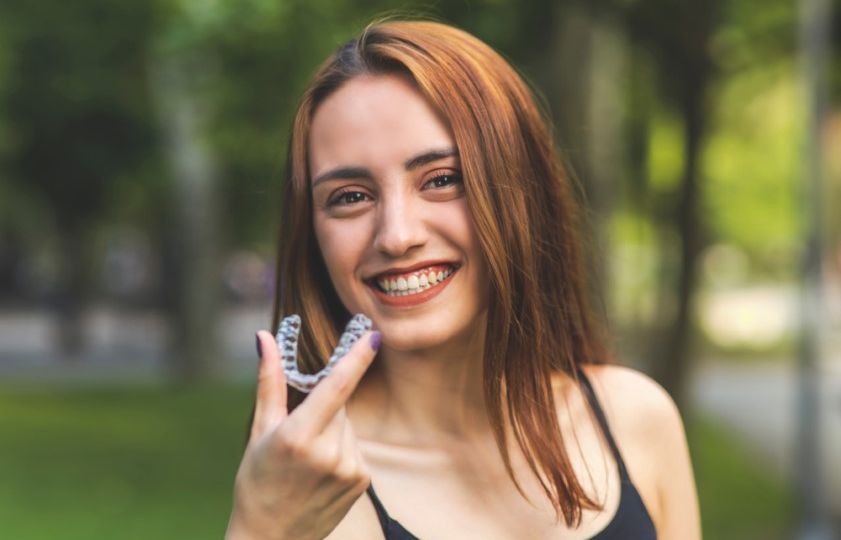
How Is Invisalign Different From Braces?
While braces use metal wires and elastics to gradually shift your teeth into place, Invisalign uses sets of clear, completely customized plastic trays. Both methods of treatment achieve amazing results, just in different ways, with different treatment plans. Below are some key differences between the two:
- Braces can treat some of the most severe malocclusions, while Invisalign can only handle them up to a certain point
- Braces are not removable while Invisalign trays are, meaning you don’t have to change your diet during Invisalign treatment
- Invisalign is designed to be almost entirely transparent, while braces are quite visible
- Invisalign can be more comfortable than traditional metal braces
- Because there aren’t any brackets or elastics in the way, it’s easier to maintain good oral health with Invisalign
Does Invisalign Hurt?
While Invisalign itself isn’t painful, the adjustment period can be for some. In the beginning, your mouth won’t be used to the added pressure and can become sore as your aligners begin to shift your teeth into place. Don’t worry – this is a normal process, and the discomfort will minimize in time. You can use ibuprofen as directed to manage the pain.
Even if it’s uncomfortable at first, it’s important to wear your Invisalign as much as you can. This will help your mouth adjust faster, and get you to a pain-free place in no time. We also recommend switching into your new aligners at night, so you’re asleep while your mouth adjusts to the new, slightly tighter set.
How Long Does Treatment Take?
The length of orthodontic treatment will always vary for everyone, as every patient has entirely different needs. While some may only need Invisalign for a few months to correct a few misaligned teeth, others may be in it for the long haul, and treatment could take 1-2 years. We’ll evaluate your own unique situation, your oral malocclusions, and be able to give you an approximate estimate of how long your Invisalign journey will take.
Can Invisalign Fix My Smile?
Invisalign can treat a variety of issues, and even severe malocclusions. Invisalign is great for treating:
- Crossbites
- Overbites
- Underbites
- Gapped teeth
- Crooked teeth
However, there are some cases that may be too complicated for Invisalign treatment. In these cases, metal braces will be able to do the job. If you decide you’re comfortable with this route, we can talk to you about your options for braces, and what your treatment plan may look like.
How Will Treatment Affect My Life?
One of the many advantages of Invisalign treatment is the ability to maintain a normal lifestyle. You won’t have to anticipate major diet changes, physical restrictions, or extra dentist appointments to have metal braces tightened.
Here are a few key things that Invisalign may change, and how you can make the process easy on yourself until you’ve completed your treatment.
Carry An Extra Case With You
If you need to have a snack or drink on the fly, it’s important to keep your aligners safe at all times. Make sure you always remove your clear aligners before eating and drinking and put them in your closed case until you’re finished. It’s easy to remove your Invisalign and leave it on the table, so make sure your case is then placed somewhere safe and secure, like a bag or a pocket. Having a case with you won’t restrict you from eating with your friends, or enjoying a quick coffee!
Carry a Travel-Sized Toothbrush and Toothpaste – Just In Case
Especially if you’ve eaten, it’s important that you never put your aligners back in before brushing your teeth. The last thing you want is for bacteria to build-up in that limited space between your teeth and your Invisalign.
Carrying travel-sized toiletries will let you eat your meals guilt-free, knowing you always have a way to brush after and maintain the hygiene of both your aligners and your teeth and gums!
Set Alarms When You Remove Your Aligners As A Reminder To Put Them Back
While it may take a bit of getting used to, it’s easy to forget your Invisalign once they’ve been taken out. It’s very important to wear them for 22 hours a day, so make sure you set reminders for yourself, especially in the beginning.
Practice Exceptional Oral Hygiene

As you work towards your new smile, it’s important to keep your teeth and gums healthy, too. Bacteria can build-up very easily on your aligners, and without proper brushing and flossing, could leave you vulnerable to oral health issues over time. Make sure you brush your teeth for at least two minutes twice per day and brush your aligners every day with lukewarm water and toothpaste.
What If I’ve Already Had Other Work Done?
Sometimes, we encounter patients that had braces as a teenager, and their teeth have since shifted back into their previous places. This can happen if a patient doesn’t wear their retainer after completing orthodontic treatment.
If you’ve already had work done and want to see what your options are for straightening your teeth again, we’re happy to help! Invisalign is great for achieving your smile goals once again, and if you’ve already had some work done, the process may not take as long as it would for someone just starting out.



